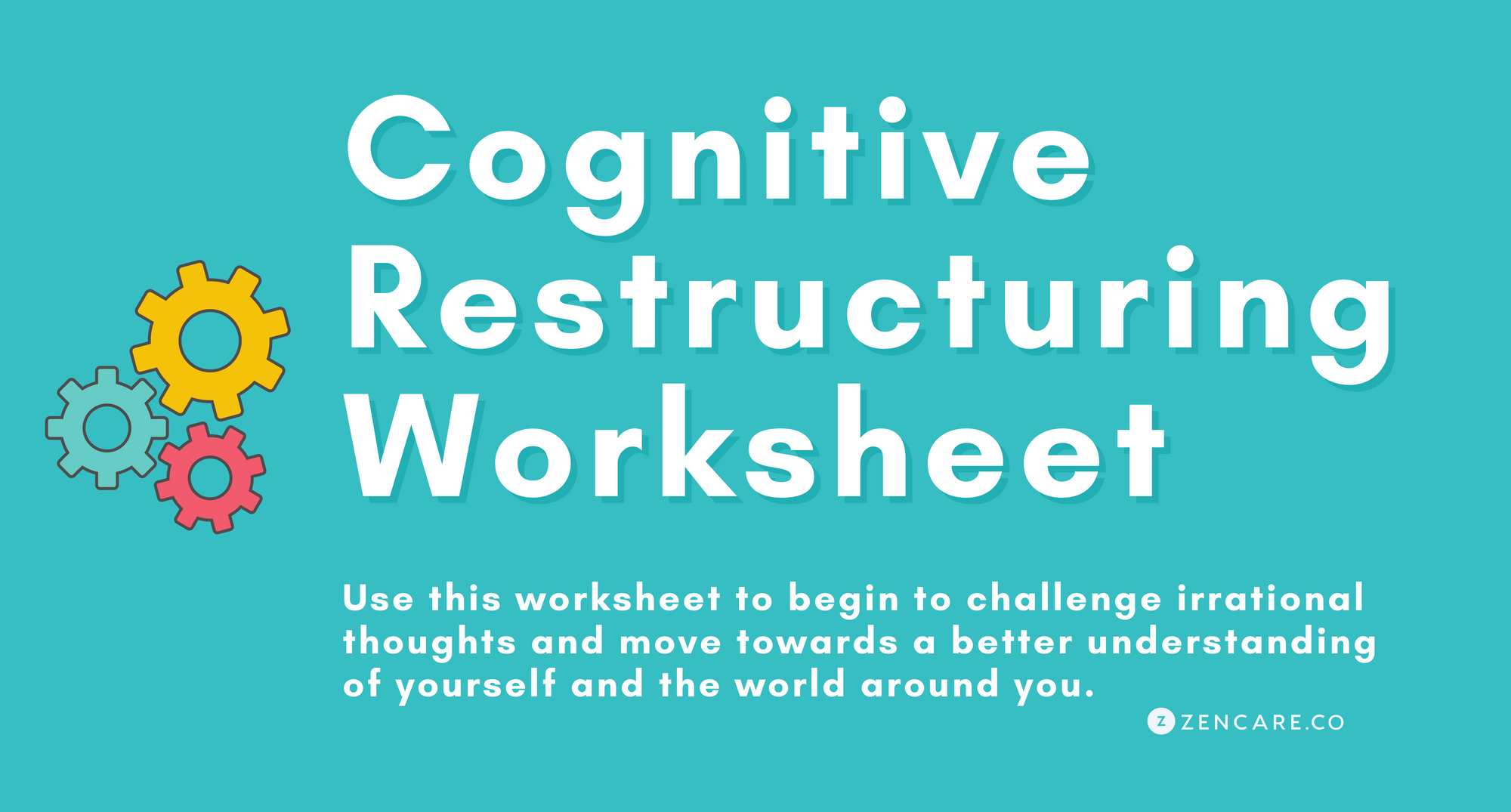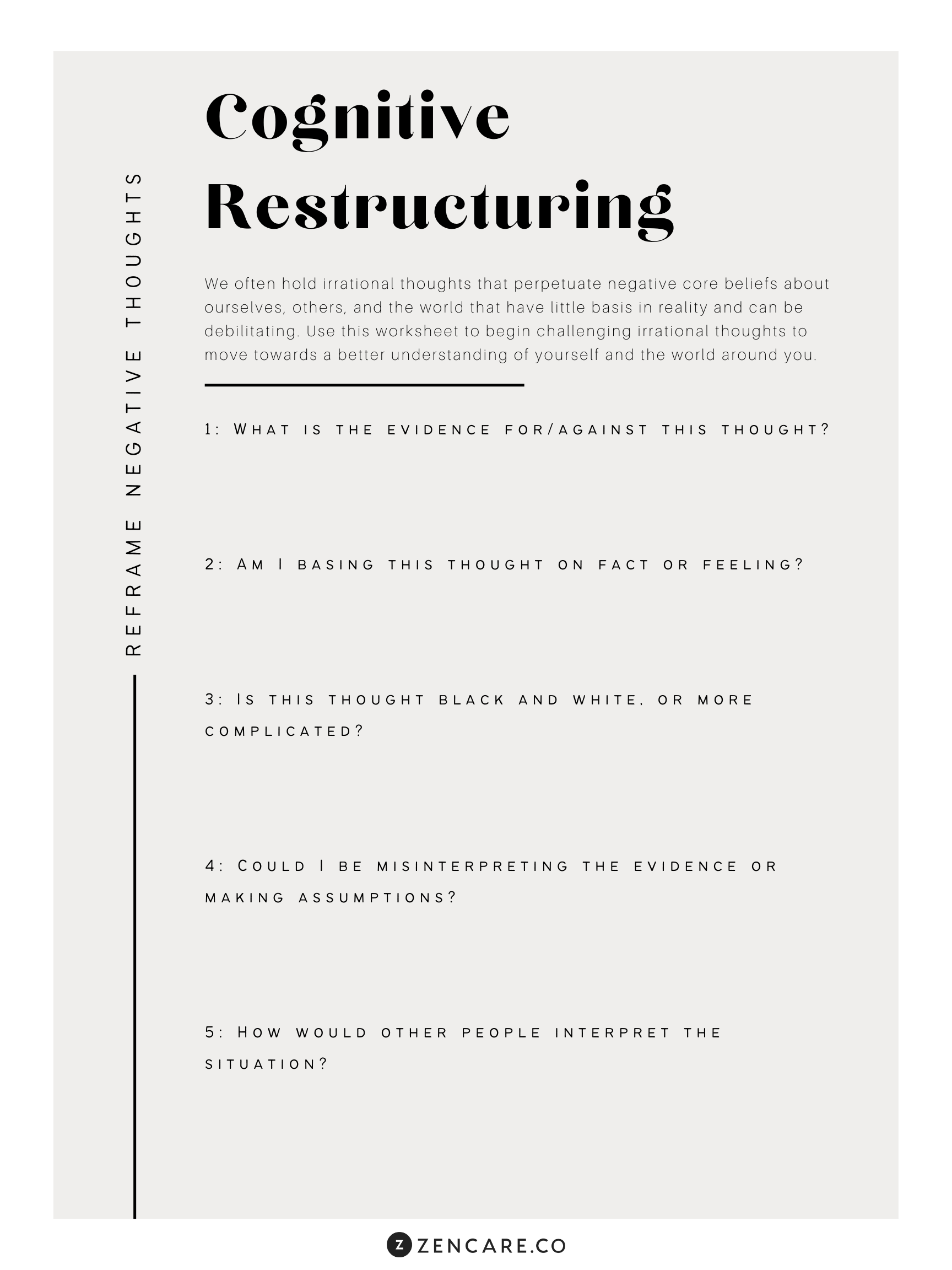Cognitive restructuring, also known as reframing, is a cognitive behavioral therapy technique used to challenge and change irrational thoughts. We often hold irrational thoughts that perpetuate negative core beliefs about ourselves, others, and the world that have little basis in reality and can be debilitating.
Read on to learn about cognitive restructuring, and how you can begin to challenge irrational thoughts to move towards a better understanding of yourself and the world around you.

What are irrational beliefs?
Before you can challenge a thought or belief, you'll need to be able to identify different types of irrational thinking. Below are examples of irrational thinking:
- All or nothing thinking: Viewing things in a rigid success/failure binary
- Overgeneralization: Interpreting one or two coincidences to mean that something is always or never true
- Mental filter: Fixating exclusively on one incident and ignoring other evidence that indicates the opposite
- Discounting the positive: Disregarding positive experiences in order to justify negative patterns
- Jumping to conclusions: Making assumptions about what will happen or what others will think based on minimal or no evidence
- Magnification: Inappropriate or inaccurate emphasis on behaviors or attributes
- Emotional reasoning: Drawing untrue or far-fetched conclusions based purely on emotion
- Should statements: Idealizing and upholding unrealistic standards
- Labeling: Conflating someone’s actions with who they are as a person
- Personalization/blame: Blaming yourself for an outcome that was not actually your fault or within your control
Understanding the various types of irrational thinking can help you begin to restructure your thoughts in order to better perceive, react to, and cope with life’s stressors.
Using Socratic Questioning to Restructure Irrational Thinking
Socratic questioning can be used as a component of CBT to bring your awareness to irrational thoughts. Once you gain an awareness of your thinking and how it may hinder you, you can begin to more quickly and successfully restructure the way you think.
In this cognitive restructuring exercise, you will start by identifying an irrational thought. You’ll then go through a list of 10 questions to help you examine the thought.
Identify an irrational thought
In this example, we’ll examine the irrational thought: I will never get promoted at my company. Other examples could include, "I'll always be alone" or "I'll never find a job a I like."
Question 1: What is the evidence for/against this thought?
Consider what evidence you have that gives credence to the thought, vs evidence that is contrary to the thought.
- Example: I was overlooked for two promotions.
- Example: Someone with less experience was promoted.
- Example: I was given additional responsibilities.
Question 2: Am I basing this thought on fact or feeling?
Does the thought you’re examining come from a place of fact, based on evidence, or a place of feeling? Does it come from both? Consider whether you are using emotional reasoning.
- Example: Both! I’ve only been at the company for nine months and there are trainings that I need to complete.
- Example: I often feel as though I am perceived as incompetent despite some colleagues asking me for assistance and feedback. Other times I feel like my expertise is ignored or undermined.
Question 3: Is this thought black and white, or more complicated?
Consider the nuances of the thought, and whether you may be overgeneralizing, using all or nothing thinking, or fixating on one aspect of the situation.
- Example: It’s a bit more complicated! My colleagues are very dynamic and highly qualified.
- Example: My boss tells me that she appreciates my efforts and eagerness, but feels that I need more time to grow.
Question 4: Could I be misinterpreting the evidence or making assumptions?
Consider whether you might be discounting the positive.
- Example: Possibly. Usually, I feel respected and appreciated by my colleagues and boss.
- Example: My colleagues asked me to collaborate a new project that I wouldn't have been on otherwise.
Question 5: How would other people interpret the situation?
Imagine how a friend or trusted family member would talk to you about this thought or concern.
- Example: You’re just starting out in your career, why would you want more responsibility?
- Example: Getting one-on-one time with your boss sounds promising.
- Example: It sounds like you’ve connected with some of your colleagues.
Question 6: Am I looking at all the evidence or just what supports my thoughts?
Consider whether or not you may be using a mental filter when examining the situation.
- Example: Yes! Actually, that’s my problem! I can’t stop ruminating over this one negative thing and then going back and forth. One minute I feel super confident, and the next, I’m so unsure.
Question 7: Could my thought be an exaggeration of what’s true?
Consider whether you may be magnifying the situation.
- Example: Most definitely! It’s true, I’ve been passed over for promotions. But maybe I’m not ready yet, and I have progressed in other ways.
Question 8: Am I having this thought out of habit or do the facts support?
Consider whether you are jumping to conclusions, or if your thought is based on solid evidence.
- Example: The facts don’t necessarily support it - I’ve been getting good feedback from my boss, even if I’m not up for a promotion just yet.
Question 9: Did someone pass this thought or belief to me, and are they a reliable source?
Consider how you came to this thought and subsequent conclusion.
- Example: No, I came to this thought on my own passed on (minimal) evidence.
Question 10: Is my thought a likely scenario, or worst case scenario?
Consider whether you are using all or nothing thinking. Does not getting promoted mean failure across the board?
- Example: Worst case scenario! Even if I don’t get promoted here, there is always room for growth somewhere else.
This exercise likely won’t immediately restructure your thinking; however the goal is to become aware of irrational thought patterns and utilize this line of questioning to challenge them.
Consider seeking support from a therapist
CBT techniques, such as cognitive restructuring, can be utilized on our own; however, it’s possible to become so consumed with our thoughts that they trip us up and affect the ways we perceive ourselves and others. A therapist who specializes in the following types of therapy can help you to restructure your irrational thinking:
- Cognitive Behavioral Therapy: This approach to psychotherapy brings awareness to how unhelpful thought patterns or beliefs impact your emotions and behavior.
- Mindfulness-Based Stress Reduction: MBSR is a group therapy that uses mindfulness practices to increase awareness and compassion.
- Positive Psychology: This approach to psychotherapy aims to improve emotional well-being and functioning by building on positive emotions, relationships, and strengths.
- Strengths-Based Therapy: This approach to psychotherapy places emphasis on what is going well in our lives.
- Solution-Focused Therapy: With this approach to psychotherapy, the therapist and client collaborate to develop solutions to problems using the client’s personal strengths and skills.
